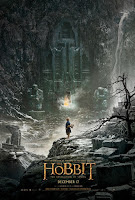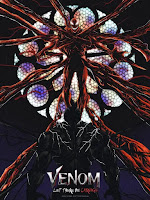WRITER'S CUT: A collection of previously-published posts that have been thoroughly re-examined and re-edited by yours truly. (The following was originally published on November 14th, 2017.)
When author J.R.R. Tolkien wrote The Hobbit in the 1930s, he had written it as a fantasy adventure for his children. Little did he know it would not only set the stage for other characters and stories in his created world of "Middle-earth" (notably The Lord of the Rings and the posthumously-released The Silmarillion), but also establish a contemporary mythology echoing stories, legends, and character types of yesteryear.
When filmmaker Peter Jackson began adapting The Lord of the Rings in the late-1990s, he and his cast and crew embarked on what would turn out to be a seven-year journey to bring Tolkien's literary trilogy to the big screen. Little did they know it would not only set a benchmark in cinema history (no trilogy had ever been filmed simultaneously, and no "fantasy" flick had ever won the Best Picture Academy Award), but also set the stage for other genre entries in the 21st Century (i.e., Harry Potter and The Chronicles of Narnia).
After Rings, Jackson went on to direct and co-produce other projects, such as his lifelong-dream remake of King Kong (2005), an adaptation of Alice Sebold's novel The Lovely Bones (2009), Neill Blomkamp's sci-fi/apartheid directorial debut District 9 (2009), and Steven Spielberg's motion-capture take on Herge's The Adventures of Tintin (2011). In the mean time, Jackson's visual effects company, Weta Digital, contributed to various other films, including the rebooted Planet of the Apes series (2011-2017), the fast-car sequel Furious 7 (2015), the holiday horrorfest Krampus (2015), and Disney's remake of Pete's Dragon (2016).
 |
| 1977's animated The Hobbit |
Tolkien's prequel novel had been adapted for the screen once before. Specifically, by animation studio Rankin-Bass for television in the late-1970s. Contrary to the 9-hour live-action trilogy, this 77-minute feature captures the childlike wonder, fantasy, and episodic nature of Tolkien's book. (Musical interludes/transitions really keep the story engaging and delightful.) Granted, there are scary moments involving goblins, Gollum, spiders, and the dragon Smaug, as well as an intense (though bloodless) climactic battle. But they're all in the realms of family-friendliness.
When original director Guillermo del Toro (2006's Pan's Labyrinth) was in pre-production for a live-action adaptation in the late-2000s, two back-to-back installments were planned. The first film would be a majority of the book, while the second film would serve as connected tissue to Jackson's LOTR trilogy. Del Toro's casting choices included Brian Blessed (as dwarf leader Thorin), Doug Jones (as Elven King Thranduil), Ian McShane (as a dwarf), and Ron Perlman (as Beorn).
In 2010, del Toro stepped down due to reported production delays, while Jackson took over directing duties for the long-awaited blockbuster. Many of the same crew from LOTR were already on board, including co-writers/co-producers Fran Walsh and Philippa Boyens, production designer Dan Hannah, cinematographer Andrew Lesnie, conceptual artists Alan Lee and John Howe, composer Howard Shore, and head of Weta Workshop Richard Taylor. (Del Toro remained credited as a project consultant.) Returning cast members included Ian Holm (the elderly Bilbo Baggins), Elijah Wood (Frodo Baggins), Hugo Weaving (Elrond), Cate Blanchett (Galadriel), Christopher Lee (Saraman), Ian McKellan (Gandalf), and Andy Serkis (Gollum, who steals the iconic "Riddles in the Dark" sequence), while newcomers Martin Freeman (a younger Bilbo) and Richard Armitage (Thorin) would join in. Serkis would eventually serve as the project's Second Unit Director.
 |
| Peter Jackson behind the scenes of The Hobbit |
Jackson, Walsh, Boyens, and Del Toro's contributions to the screenplay partly came from appendices at the end of The Return of the King text. The backstory of the dwarves and their once-glorious kingdom of Erebor were used as a prologue for the first Hobbit film, titled An Unexpected Journey. This introduction not only showcases the dwarves' greed and obsession with gold, but also its effects on the neighboring people of Dale, as well as other races. Jealousy and destruction soon appear in the form of the dragon Smaug, which leads to the downfall of the dwarves' race. Their mission in Tolkien's story and in this film: to take back the fallen kingdom. But to do this impossible task, they will need some help--particularly, a burglar to sneak in.
Which leads us to Bilbo Baggins, a hobbit who finds comfort and safety in his home in the Shire, and is not motivated by adventures of any kind. At least until the great wizard Gandalf comes knocking on his door, followed by thirteen mighty dwarves, and convinces him to take the journey. (It's curious but sort of understandable that only half of these characters, led by Thorin, are given more screen time and development than the rest of the supposedly-caricatured bunch.) At the same time, there's a greater, darker power resurfacing in Middle-earth than just Smaug, beginning with the mysterious Necromancer, as investigated by the eccentric wizard Radagast.
The overall moral in this story is that adventure is not found in the comforts of home, but out there in the world. To be sure, danger is inevitable, but courage and bravery are necessary and beneficial. Therefore, facing the world and seeing what one is really made of, not just where he comes from. "Home is now behind you," Gandalf tells Bilbo, "The world is ahead."
But despite being based on essentially a children's novel, Jackson had no interest in making a film strictly for children. This is one of the many significant liberties that makes the film quite dark and violent. And the other two films in this now-trilogy (2013's The Desolation of Smaug and 2014's The Battle of the Five Armies) verify that point, along with many other controversial choices that have more to do with Jackson's previous film trilogy than with Tolkien's original book. Little did Jackson and company (and moviegoers, for that matter) know that the overall reception for these prequel installments would be lukewarm.
When The Desolation of Smaug came out, I began to loose faith in these films. For one thing, Weta Digital certainly went to great lengths to make knock-out effects sequences. And there certainly are many worthy moments and worthwhile elements, such as the impressive animation of Smaug and the designs of Laketown and Erebor. But they're upstaged by the aforementioned (and prolonged) scenes and VFX shots, not to mention an "unexpected" and sudden climax to the middle chapter. I had hopes that the third movie (originally titled There and Back Again, like the original subtitle of the book, as well as the original title for the second film) would deliver a more satisfying outing. And yet, when film three did arrive (and with a new title), the result was a rather underwhelming experience. (In the book, the climactic battle lasts one chapter whereas, in the film, it's nearly 45 minutes). It also proved that this "prequel trilogy" was probably not a good idea. Jackson admitted in 2014/2015 that the reception to these three films was partially due to him coming so late into pre-production, with only three months to plan. (Compare that to the reported three years Jackson and company spent preparing The Lord of the Rings).
That's not to say the making of The Hobbit was a terrific experience, as the "Production Diaries" filmed between 2011 and 2012 in New Zealand showcased. (The behind-the-scenes videos on the "Extended Edition" bluray/DVD releases are more in-depth.) These videos are, without a doubt, the highlight of these films, as well as an amazing transition into a new decade for Tolkien's stories and epic fantasy worlds.
On the other hand, Jackson has defended his decision to expand the story into a trilogy in order to, by request to the studios (Warner Bros/New Line and MGM), plan out the climactic "battle." I recently viewed all three "extended" versions back-to-back and now believe that Five Armies is, while emotionally-effecting, an overbearing and unnecessary conclusion to Tolkien's classic. (It honestly should've lasted the same length as the final battle in 2003's The Return of the King.) Even Bilbo himself ends up feeling like a supporting character halfway through this series.
What these films could have used was a little old-fashioned restraint. Here are four things that I would have eliminated or reduced, and which would've resulted in two films instead of three.
1. The villainous orc Azog. The climax that ended up in An Unexpected Journey should've been saved for The Battle of the Five Armies, where Thorin would've have a proper face-off with this vengeful adversary, while him and Bilbo and the other dwarves would've transitioned better from the goblin tunnels to Beorn's house. (To be fair, Bilbo's bravery is commendable and amazing in the resulting sequence, though that would've been evident after the Mirkwood spiders and dungeon escapes anyway.)
3. The romance between dwarf Kili and elf Tauriel (a character made for the movies, due to an apparent lack of female characters in Tolkien's novels), as well as a subtle love triangle involving Legolas; ditto the subtle romance between Gandalf and Lady Galadriel. If they had made Tauriel a companion to the dwarves and not so much a love interest, that would've been stronger and less conventional. (Actress Evangeline Lilly did express disappointment that the studio reportedly went with the aforementioned love-triangle, contrary to what she believed she signed on for.)
4. The emphasis on the subplot about the darkness resurfacing in Middle-Earth, including the re-emergence of Sauron, creates the same mistake that George Lucas's Star Wars prequel series made: it tells you what happens in the original trilogy, and you loose those thrills when viewing these films in chronological order. The shifts that An Unexpected Journey makes midway through (and which Desolation does a lot, while Five Armies is more of an Appendices feature film) distract from what should be the primary story--the dwarves' quest and its impact on Middle-Earth. If this would've been the sole storyline (plus the theme of "dragon sickness" and not so much the Ring's growing power over Bilbo), then the films would've been a whole lot better, and most certainly only two installments.
 |
| A great, quiet moment beween Bilbo and Gandalf |
As movies themselves, they're entertaining. But compared with the book and the LOTR films, they're longer than they need to be. Unlike the original trilogy, which began with miniature sets and grounded visual effects, the Hobbit films use CGI extensively. The settings of Dol Guldur and the Elven city in Mirkwood are clearly unrealistic, more resembling video games. It even got to the point where actor Ian McKellan wasn't performing alongside the other actors for much of the time, contrary to the "forced perspective" technique they used for The Fellowship of the Ring. The overall production design is spectacular and very Tolkien-esque, from Rivendale to Laketown, the ruins of Dale, and Five Armies' illustrated end credits. But the effect (and some of the humor, rather gratuitous) is far from it. It's overbearing, menacing, and downright savage. (The Extended Edition of Five Armies received an R-rating.)
At least Tolkien's themes are still intact and strong, including a misguided sense of loss and the cost of greed, war and destruction. And filmgoers can't go wrong with the "Song of the Lonely Mountain," a motif throughout the first film that should've resurfaced in the other installments. This is, after all, the emotional arc of the dwarves and their journey. It's fair to say Jackson has (hopefully) learned from the mistakes of these films. (He's spent the last several years making documentary features on WWI and the Beatles.) As for Tolkien's original works, they will remain timeless and definitive.
Still, it would've been amazing to see del Toro's cancelled vision come to life. (Read here for more behind-the-scenes details courtesy Screenrant.)








.webp)






